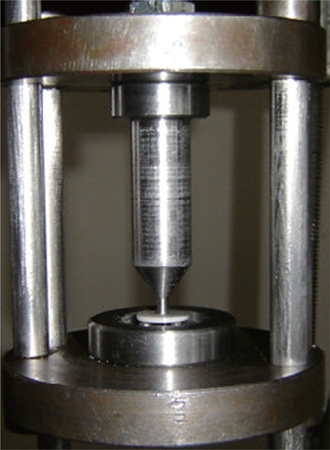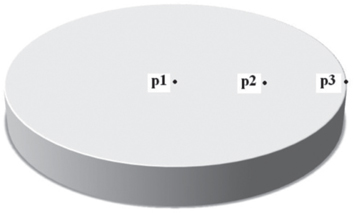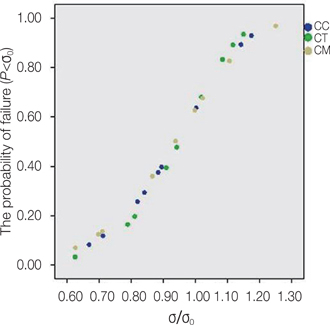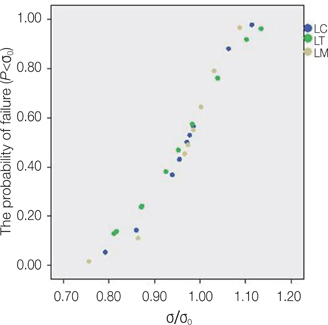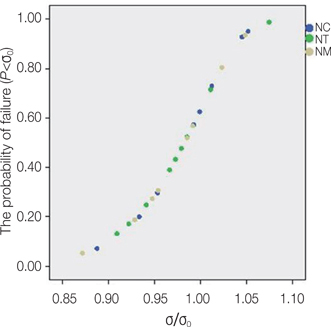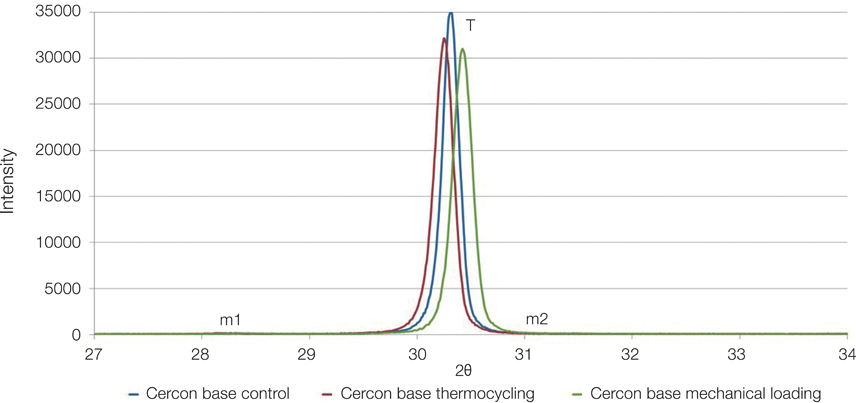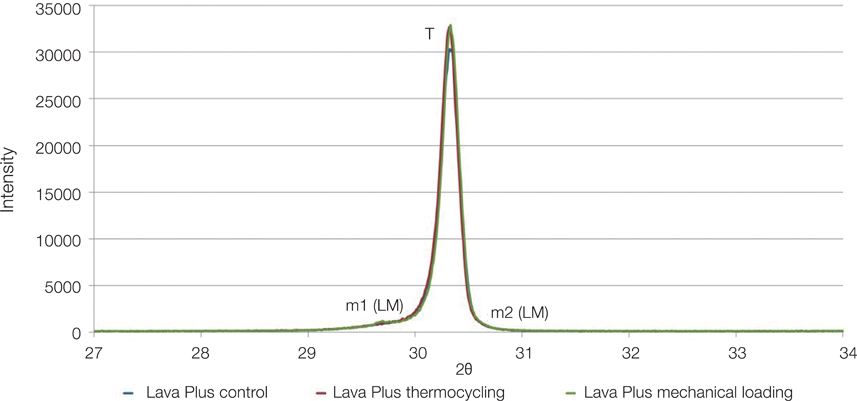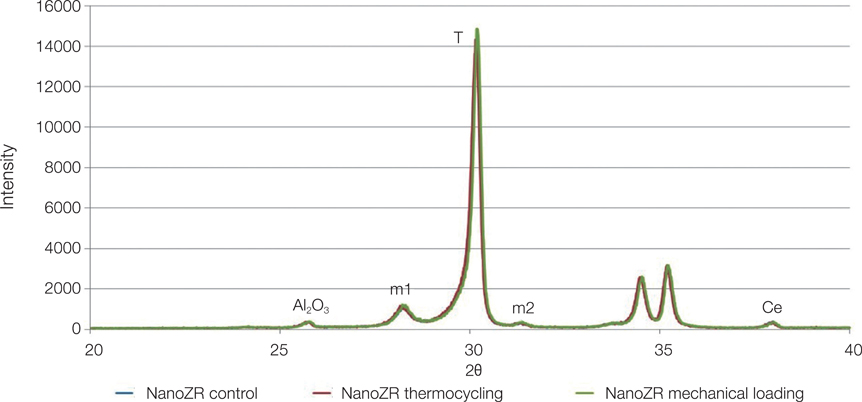J Adv Prosthodont.
2014 Jun;6(3):224-232. 10.4047/jap.2014.6.3.224.
Biaxial flexural strength and phase transformation of Ce-TZP/Al2O3 and Y-TZP core materials after thermocycling and mechanical loading
- Affiliations
-
- 1Department of Prosthodontics, Faculty of Dentistry, Gazi University, Ankara, Turkey. hozkula@gmail.com
- 2Department of Physics, Faculty of Science, Anadolu University, Eskisehir, Turkey.
- KMID: 2118234
- DOI: http://doi.org/10.4047/jap.2014.6.3.224
Abstract
- PURPOSE
The purpose of the present study was to evaluate the effect of thermocycling and mechanical loading on the biaxial flexural strength and the phase transformation of one Ce-TZP/Al2O3 and two Y-TZP core materials.
MATERIALS AND METHODS
Thirty disc-shaped specimens were obtained from each material. The specimens were randomly divided into three groups (control, thermocycled, and mechanically loaded). Thermocycling was subjected in distilled water for 10000 cycles. Mechanical loading was subjected with 200 N loads at a frequency of 2 Hz for 100000 times. The mean biaxial flexural strength and phase transformation of the specimens were tested. The Weibull modulus, characteristic strength, 10%, 5% and 1% probabilities of failure were calculated using the biaxial flexural strength data.
RESULTS
The characteristic strengths of Ce-TZP/Al2O3 specimens were significantly higher in all groups compared with the other tested materials (P<.001). Statistical results of X-ray diffraction showed that thermocycling and mechanical loading did not affect the monoclinic phase content of the materials. According to Raman spectroscopy results, at the same point and the same material, mechanical loading significantly affected the phase fraction of all materials (P<.05).
CONCLUSION
It was concluded that thermocycling and mechanical loading did not show negative effect on the mean biaxial strength of the tested materials.
Keyword
Figure
Reference
-
1. Cattani-Lorente M, Scherrer SS, Ammann P, Jobin M, Wiskott HW. Low temperature degradation of a Y-TZP dental ceramic. Acta Biomater. 2011; 7:858–865.2. Yilmaz H, Nemli SK, Aydin C, Bal BT, Tıraş T. Effect of fatigue on biaxial flexural strength of bilayered porcelain/zirconia (Y-TZP) dental ceramics. Dent Mater. 2011; 27:786–795.3. Piconi C, Maccauro G. Zirconia as a ceramic biomaterial. Biomaterials. 1999; 20:1–25.4. Kohorst P, Borchers L, Strempel J, Stiesch M, Hassel T, Bach FW, Hübsch C. Low-temperature degradation of different zirconia ceramics for dental applications. Acta Biomater. 2012; 8:1213–1220.5. Yang G, Li JC, Wang GC, Yashima M, Min SL, Chen TC. Investigation on strengthening and toughening mechanisms of Ce-TZP/Al2O3 nanocomposites. J Metall Mater Trans A. 2006; 37:1969–1975.6. Mangalaraja RV, Chandrasekhar BK, Manohar P. Effect of ceria on the physical, mechanical and thermal properties of yttria stabilized zirconia toughened alumina. Mater Sci Eng A. 2003; 343:71–75.7. Nawa M, Nakamoto S, Sekino T, Niihara K. Tough and strong Ce-TZP/Alumina nanocomposites doped with titania. Ceram Int. 1998; 24:497–506.8. Ban S. Reliability and properties of core materials for all-ceramic dental restorations. Jpn Dent Sci Rev. 2008; 44:3–21.9. Tanaka K, Tamura J, Kawanabe K, Nawa M, Uchida M, Kokubo T, Nakamura T. Phase stability after aging and its influence on pin-on-disk wear properties of Ce-TZP/Al2O3 nanocomposite and conventional Y-TZP. J Biomed Mater Res A. 2003; 67:200–207.10. Nawa M, Bamba N, Sekino T, Niihara K. The effect of TiO2 addition on strengthening and toughening in intragranular type of 12Ce-TZP/Al2O3 nanocomposites. J Eur Ceram Soc. 1998; 18:209–219.11. Ban S, Sato H, Suehiro Y, Nakanishi H, Nawa M. Biaxial flexure strength and low temperature degradation of Ce-TZP/Al2O3 nanocomposite and Y-TZP as dental restoratives. J Biomed Mater Res B Appl Biomater. 2008; 87:492–498.12. Hirano M, Inada H. Fracture toughness, strength and Vickers hardness of yttria-ceria-doped tetragonal zirconia/alumina composites fabricated by hot isostatic pressing. J Mater Sci. 1992; 27:3511–3518.13. Fischer J, Stawarczyk B. Compatibility of machined Ce-TZP/Al2O3 nanocomposite and a veneering ceramic. Dent Mater. 2007; 23:1500–1505.14. Borchers L, Stiesch M, Bach FW, Buhl JC, Hübsch C, Kellner T, Kohorst P, Jendras M. Influence of hydrothermal and mechanical conditions on the strength of zirconia. Acta Biomater. 2010; 6:4547–4552.15. Perdigão J, Pinto AM, Monteiro RC, Braz Fernandes FM, Laranjeira P, Veiga JP. Degradation of dental ZrO2-based materials after hydrothermal fatigue. Part I: XRD, XRF, and FESEM analyses. Dent Mater J. 2012; 31:256–265.16. Pittayachawan P, McDonald A, Petrie A, Knowles JC. The biaxial flexural strength and fatigue property of Lava Y-TZP dental ceramic. Dent Mater. 2007; 23:1018–1029.17. Ban S, Suehiro Y, Nakanishi H, Nawa M. Fracture toughness of dental zirconia before and after autoclaving. J Ceram Soc Jpn. 2010; 118:406–409.18. Sato H, Yamada K, Pezzotti G, Nawa M, Ban S. Mechanical properties of dental zirconia ceramics changed with sandblasting and heat treatment. Dent Mater J. 2008; 27:408–414.19. Nakamura T, Yamashita K, Neo M. Mechanical properties of zirconia/alumina nano-composite after soaking in various water-based conditions. Key Eng Mater. 2006; 309-11:1219–1222.20. Takano T, Tasaka A, Yoshinari M, Sakurai K. Fatigue strength of Ce-TZP/Al2O3 nanocomposite with different surfaces. J Dent Res. 2012; 91:800–804.21. Gale MS, Darvell BW. Thermal cycling procedures for laboratory testing of dental restorations. J Dent. 1999; 27:89–99.22. Fontijn-Tekamp FA, Slagter AP, Van Der Bilt A, Van 'T Hof MA, Witter DJ, Kalk W, Jansen JA. Biting and chewing in overdentures, full dentures, and natural dentitions. J Dent Res. 2000; 79:1519–1524.23. ISO 6872. Dentistry-ceramic materials. Geneva; Switzerland: International Organization for Standardization;2008.24. Garvie RC, Nicholoson PS. Phase analysis in zirconia systems. J Am Ceram Soc. 1972; 55:303–305.25. Kim BK, Hahn JW, Han KR. Quantitative phase analysis in tetragonal-rich tetragonal/monoclinic two phase zirconia by Raman spectroscopy. J Mater Sci Lett. 1997; 16:669–671.26. Bona AD, Anusavice KJ, DeHoff PH. Weibull analysis and flexural strength of hot-pressed core and veneered ceramic structures. Dent Mater. 2003; 19:662–669.27. Studart AR, Filser F, Kocher P, Gauckler LJ. Fatigue of zirconia under cyclic loading in water and its implications for the design of dental bridges. Dent Mater. 2007; 23:106–114.28. Karakoca S, Yilmaz H. Influence of surface treatments on surface roughness, phase transformation, and biaxial flexural strength of Y-TZP ceramics. J Biomed Mater Res B Appl Biomater. 2009; 91:930–937.29. Gupta TK, Lange FF, Bechtold JH. Effect of stress-induced phase transformation on the properties of polycrystalline zirconia containing metastable tetragonal phase. J Mater Sci. 1978; 13:1464–1470.30. Kailer A, Nickel KG, Gogotsi YG. Raman microspectroscopy of nanocrystalline and amorphous phases in hardness indentations. J Raman Spectrosc. 1999; 30:939–946.31. Behrens G, Dransmann GW, Heuer AH. On the isothermal martensitic transformation in 3Y-TZP. J Am Ceram Soc. 1993; 76:1025–1030.32. Nemli SK, Yilmaz H, Aydin C, Bal BT, Tıraş T. Effect of fatigue on fracture toughness and phase transformation of Y-TZP ceramics by X-ray diffraction and Raman spectroscopy. J Biomed Mater Res B Appl Biomater. 2011; 11. 21.
- Full Text Links
- Actions
-
Cited
- CITED
-
- Close
- Share
- Similar articles
-
- An experimental study on hydrothermal degradation of cubic-containing translucent zirconia
- The effects of surface grinding and polishing on the phase transformation and flexural strength of zirconia
- Change of phase transformation and bond strength of Y-TZP with various hydrofluoric acid etching
- The effect of low temperature aging on the mechanical property & phase stability of Y-TZP ceramics
- Effect of different grinding burs on the physical properties of zirconia

